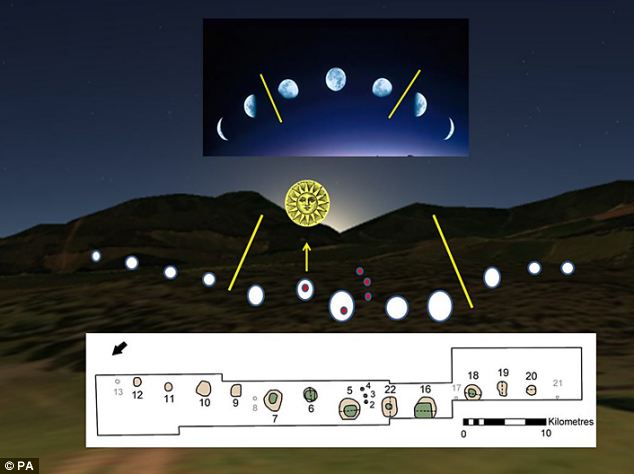At www.dailymail.co.uk/sciencetech/article-2364281/ … we learn about a strange configuration of pits spotted by aerial archaeology at Crothes Castle in Scotland. It is said to be the world's oldest (known) calendar dating back to around 8000BC ..
 … a little digging around found some more links. At www.universetoday.com/103967/ancient-astronomical-calendar-discovered-in… … a team from Birmingham University led by landscape archaeologist Vince Gaffney was called in to look at what is basically a series of pits. Originally unearthed by National Trust for Scotland archaeologists (back in 2004) we have 12 pits arranged in an arc 54m long. It is thought they correspond to 12 lunar months – plus an added correction to bring the calendar back into sync with the solar year (at winter solstice). The date is firmly within the Mesolithic era which was a hunter gatherer society, it is thought. We know they had boatyards from the Mesolithic site in the Solent and at 8000 years ago the North Sea would have been a completely different configuration to what it is today. Dogger Land would still have existed – which is where Gaffney made his name. Why did hunter gatherers have a need to monitor the moon – or have a calendar? All the link cansuggest is time keeping.
… a little digging around found some more links. At www.universetoday.com/103967/ancient-astronomical-calendar-discovered-in… … a team from Birmingham University led by landscape archaeologist Vince Gaffney was called in to look at what is basically a series of pits. Originally unearthed by National Trust for Scotland archaeologists (back in 2004) we have 12 pits arranged in an arc 54m long. It is thought they correspond to 12 lunar months – plus an added correction to bring the calendar back into sync with the solar year (at winter solstice). The date is firmly within the Mesolithic era which was a hunter gatherer society, it is thought. We know they had boatyards from the Mesolithic site in the Solent and at 8000 years ago the North Sea would have been a completely different configuration to what it is today. Dogger Land would still have existed – which is where Gaffney made his name. Why did hunter gatherers have a need to monitor the moon – or have a calendar? All the link cansuggest is time keeping.
Later, they speculate it may have been a luni-solar calendar which employed the use of intercalary periods to bring the lunar and solar calendar back into sync. The modern Jewish calendar is an example of a luni-solar hybrid, and there has previously been claims the Celts, or druids, used a luni solar calendar – but that was much later.
There is more on the discovery and calendar interpretation in Current Archaeology (back in 2013) – see www.archaeology.co.uk/articles/features/mesolithic-timelords-a-monumenta… … which refers to Vince Gaffney and the team that came out with the calendar intepretation. It seems people were interested in the sky throughout the Holocene – at Gobekli Tepe in SE Anatolia for example, dated even earlier. Then we have controversial evidence of Palaeolithic interest in the sky – in the Ice Age. Clive Ruggles is quoted as being favourable to the idea of a calendar which is odd as he has written and criticised Euan Mackie and his idea of a Megalithic calendar, and calendrical interpretation of stone circles etc. Ruggles was instrumental in squashing the ideas of Alexander and Archie Thom and subsequently brought the study of archaeoastronomy in the UK to a standstill, so much so archaeologists don't mention it much and we get all sorts of weird ideas surrounding Stonehenge – from healing to a funeral site. Vicne Gaffney has too much clout to be tossed aside easily so we might expect Ruggles to come out with an article shortly on the subject – as he did with Mackie.
Another interesting link is at www.bbc.co.uk/news/uk-scotland-north-east-orkney-shetland-23286928/ … it might be worth digging out Euan Makie's old articles and giving them another airing.
